

The Newspaper Industry Overall. The newspaper industry was, in many ways, was the news sector hit first and hardest by the advent of the digital age.

As readers began to move online, papers were still producing strong profit margins with the vast majority of revenues tied to their legacy product.
ASNE census finds 2,600 newsroom jobs were lost in 2012. The American Society of News Editors released its annual newsroom census today and found an unexpected acceleration of job losses.
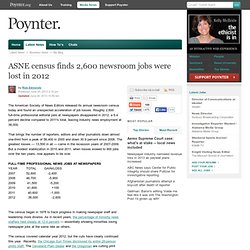
Roughly 2,600 full-time professional editorial jobs at newspapers disappeared in 2012, a 6.4 percent decline compared to 2011′s total, leaving industry news employment at 38,000. That brings the number of reporters, editors and other journalists down almost one-third from a peak of 56,400 in 2000 and down 30.9 percent since 2006. After The Spike and After The Like — A Brief History of Attention. Notes on emerging patterns of digital attention These notes are from my talk at the Digital Shoreditch conference today.
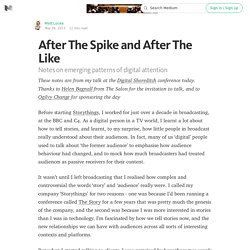
Thanks to Helen Bagnall from The Salon for the invitation to talk, and to Ogilvy Change for sponsoring the day Before starting Storythings, I worked for just over a decade in broadcasting, at the BBC and C4. As a digital person in a TV world, I learnt a lot about how to tell stories, and learnt, to my surprise, how little people in broadcast really understood about their audiences.
In fact, many of us ‘digital’ people used to talk about ‘the former audience’ to emphasise how audience behaviour had changed, and to mock how much broadcasters had treated audiences as passive receivers for their content. It wasn’t until I left broadcasting that I realised how complex and controversial the words ‘story’ and ‘audience’ really were. Newspapers Turning Ideas into Dollars. In America’s embattled newspaper industry, some business innovations are showing clear signs of success, according to a new report by the Pew Research Center.
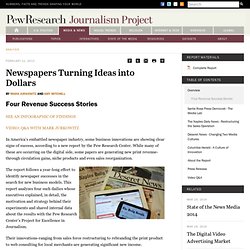
While many of these are occurring on the digital side, some papers are generating new print revenue-through circulation gains, niche products and even sales reorganization. The report follows a year-long effort to identify newspaper successes in the search for new business models. This report analyzes four such dailies whose executives explained, in detail, the motivation and strategy behind their experiments and shared internal data about the results with the Pew Research Center’s Project for Excellence in Journalism. Their innovations-ranging from sales force restructuring to rebranding the print product to web consulting for local merchants-are generating significant new income. One paper, contrary to a downward industry trend, has enjoyed an increase in overall revenue in both 2011 and 2012. “Post-Industrial Journalism”: A new Columbia report examines the disrupted news universe.
Study: Newspapers still #1 source for news. An early morning subway commuter reads a newspaper with a front page announcing news of an al Qaeda terror threat, Sept. 9, 2011, in New York.

AP Photo Revenues are plummeting. Circulation numbers continue to spiral down. Their staffs shrink with alarming regularity. Still, Americans turn to newspapers, both in print and online, more often for a wider range of information than any other news source, according to a new study from the Pew Research Center. Newspapers and newspaper websites ranked first or tied for first in the study as the source people rely on most for 11 of the 16 key topics examined--most of them civically-oriented topics such as local government, taxes and zoning.
Still, TV remains the most popular news source. Media Ownership. In the Netherlands, a Patch-like hyperlocal network is making money and nearing profit. In the United States, there are any number of individual hyperlocal sites that are proving sustainable — Berkeleyside, West Seattle Blog, and the like.

What’s proved more elusive is a way to take those individual successes and systemize them — to make them replicable across a larger scale. The best known effort to do so, AOL’s Patch, has had a rough go thus far: An activist shareholder estimates that in 2011, Patch’s 800-plus sites generated just $13 million in revenue against $160 million in expenses, and AOL is cutting costs. But across the Atlantic, there’s a more optimistic example. The Netherlands’ Dichtbij — “close to me” in Dutch — is a hyperlocal news platform that’s generating real revenue despite operating on a much smaller scale. Across its 80 sites, Dichtbij is on pace for revenue of €10 million (about $12.5 million) in 2012, according to Het Financieele Dagblad, the Netherlands’ leading financial newspaper.
Dbtruck.csail.mit.edu. 3 new ideas on the future of news from MIT Media Lab students. Ethan Zuckerman of the MIT Center for Civic Media taught a class this semester tailor-made for Nieman Lab readers: “News in the Age of Participatory Media.”
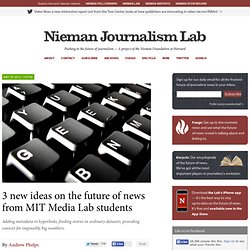
The hook: What happens if you treat journalism as an engineering problem, bringing together the efforts of journalists and computer scientists? Google’s Richard Gingras: We are at the beginning of a journalism renaissance. Richard Gingras, the head of news products for Google, visited the Nieman Foundation last Friday to talk about Google’s approach to news and information discovery, but also the pace of change in technology and how it has affected the future of news.

Recently Gingras has spent time talking about his 8 questions that will define the future of journalism. On Friday he said newspapers need to completely rethink their approach to news, how the design of their site responds to the flow of audience and the ways news companies can separate their business model and content model to help increase audience and generate revenues. A Twin Cities turnaround? The Star Tribune carves a path back through growing audience. In 2009, the Star Tribune found itself on a dubious list: The 10 Most Endangered Newspapers in America.
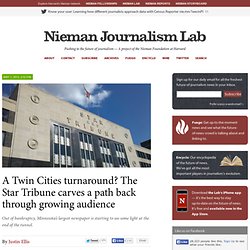
That was the year Minnesota’s largest daily entered into bankruptcy after rounds of cost-cutting couldn’t help the company ease its debt load. It wasn’t particularly unusual to see a newspaper company enter into Chapter 11 in those dark days. The Last Savior of Newspapers: Rich and Local Owners - Peter Osnos - Business. The Philadelphia Inquirer was recently saved by a group of investors who bought the paper for "the benefit of the community.
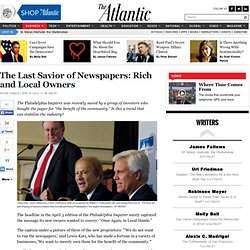
" Is this a trend that can stabilize the industry? Lewis Katz, center, addresses a news conference while accompanied by William P. Hankowsky, left, and George Norcross III. Google’s Richard Gingras: 8 questions that will help define the future of journalism. Editor’s note: At TechRaking 2012 today — a conference at the Googleplex in Mountain View, sponsored by Google and the Center for Investigative Reporting — a group of journalism doers and thinkers will be talking about how news and technology can evolve together. Opening the gathering was Google’s head of news products, Richard Gingras, a man with longstanding experience in the space where news and tech meet, who provoked discussion by raising eight areas of inquiry that might prove fruitful for the day. Here are those eight, in the form of his prepared remarks. These are extraordinary times.
These are exciting times. There has been tremendous disruption, but let’s consider the huge positives that underly that disruption. While technology holds great promise, it’s important to recognize that while technology has value it has no “values.” 72% of Americans Follow Local News Closely. Most adults follow local news closely, relying on local newspapers and other sources Nearly three quarters (72%) of adults are quite attached to following local news and information, and local newspapers are by far the source they rely on for much of the local information they need. In fact, local news enthusiasts are substantially more wedded to their local newspapers than others.
Mobile and the news media's imploding business model. Pew research has a new survey showing that tablets and smart phones are now 27% of Americans' primary news source. The overwhelming share of this is phones, not tablets; and a reasonable view says this will rise to 50% in three years. Makes sense: just as radio became one of the big purveyors of news because it was the medium that traveled with you, so should mobile. But it is also a depressing development, portending, once again, the end of the world as we know it: the news business has been plunged into a crisis because web advertising dollars are a fraction of old media money.
And mobile is now a fraction of web: the approximate conversion rate is $100 offline = $10 on the web = $1 in mobile. In part, the reasons are purely mechanical: you can cram three or four ads on a web page, meaning an average web CPM (cost per thousand views) of $1.00 (if you're lucky) can become a rate-per-page per thousand (RPM) of $4.00 (versus $20-$40 CPMs in traditional media). Is a paywall coming to The Washington Post? The Post feels that it first has to accomplish two goals before it would even consider charging for digital content. Step One: The Post has to attract more readers to its Web site. Indeed, the company is increasingly focused on this goal, and according to internal numbers, The Post’s online traffic has steadily, and significantly, grown in the past year. Industry experts say that, to make a paywall work, you have to have a loyal core of readers who come frequently to the Web site and stay awhile. This core has to be several hundred thousand readers strong before it makes sense to charge them and take the risk of losing more fickle users who will go elsewhere for online news.
The Post doesn’t think that its core of loyal readers is large enough yet to consider a paywall, but it hopes to get there in a year, maybe two. Step Two: The Post has to improve information technology systems — software and hardware — that run the Web site so that it works quickly for users. Patrick B. Newspapers Are The Fastest Shrinking Industry In The U.S. Where’s the money coming from? Fresh Pew data on the uncertain economics of newspapers. News executives acknowledge ‘toxic’ cultural divide between print and digital.
The Collapse of Print Advertising in 1 Graph - Derek Thompson - Business. Call it creative if you want, but this is what economic destruction looks like. Print newspaper ads have fallen by two-thirds from $60 billion in the late-1990s to $20 billion in 2011. You sometimes hear it said that newspapers are dead. Now, $20 billion is the kind of "dead" most people would trade their lives for. You never hear anybody say "bars and nightclubs are dead! " when in fact that industry's current revenue amounts to an identical $20 billion. So the reason newspapers are in trouble isn't that they aren't making lots of money -- they still are; advertising is a huge, huge business, as any app developer will try to tell you -- but that their business models and payroll depend on so much more money.
2011 a year of record growth for latimes.com. Behind Newspaper Deals, Web Ads and Real Estate. Food Network Executive to Run YouTube Food Channel. CNN’s just-revamped iReport: Imagine all the data! The State of the News Media 2011. Is the internet making journalism better or worse? Yes. For the past several days, The Economist has been hosting a debate between journalism professor Jay Rosen and digital skeptic and author Nicholas Carr, as part of an ongoing series about the future of media. AnnenbergTeam. Don’t call it retirement: An exit interview with Bill Kling, public radio’s original entrepreneur. House Hunters, data edition: Meet Curbwise, the Omaha World-Herald’s real-estate news app. The Innovation Journalism Blog. Brooke Gladstone's The Influencing Machine: A comic-book manifesto about the state of the American media. (1) - By Brooke Gladstone. It takes me an absurdly long time to form an opinion.
Navigating News Online. Moneyball and paywalls: Lessons on paid content from smaller papers. Clay Shirky: How cognitive surplus will change the world. Overview. Newspapers: By the Numbers. The newsonomics of story cost accounting. Search Results. The New York Times’ R&D Lab has built a tool that explores the life stories take in the social space.